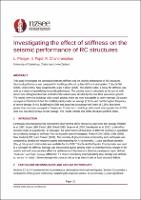| dc.contributor.author | Pledger, Liam | |
| dc.contributor.author | Pujol, Santiago | |
| dc.contributor.author | Chandramohan, Reagan | |
| dc.date.accessioned | 2023-08-28T04:23:24Z | |
| dc.date.available | 2023-08-28T04:23:24Z | |
| dc.date.issued | 2023-04-19 | |
| dc.identifier.uri | https://repo.nzsee.org.nz/xmlui/handle/nzsee/2570 | |
| dc.description.abstract | This study investigates the correlation between stiffness and the seismic performance of RC structures. Structural performance was compared for buildings affected by four different earthquakes, Tokachi-Oki (1968), Chile (1985), New Zealand (2011) and Taiwan (2016). The priority index, a proxy for stiffness, was used as a means of quantifying structural performance. The priority index is calculated as the sum of wall area in one orthogonal direction and half of the column area, divided by the total floor area aboveground. The results show that buildings with a small priority index are more susceptible to severe damage. Structures surveyed in Christchurch had the smallest priority index on average (0.14 %) and had the highest frequency of severe damage (54%). Buildings in Chile and Japan had an average wall index of 0.35%, four times greater than structures surveyed in Taiwan and Christchurch. Buildings with a wall index greater than 0.20% were 15x less likely to have severe damage. The results indicate that stiffer structures perform better. | |
| dc.language.iso | en | |
| dc.publisher | New Zealand Society for Earthquake Engineering | |
| dc.relation.ispartofseries | 2023;20 | |
| dc.subject | Quantifying and addressing uncertainties in seismic design | |
| dc.title | Investigating the effect of stiffness on the seismic performance of RC structures | |
| dc.type | Article | |

